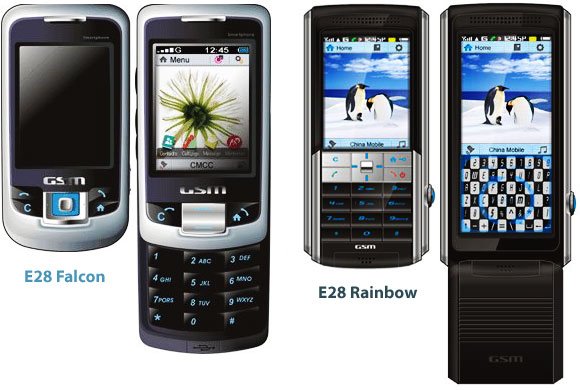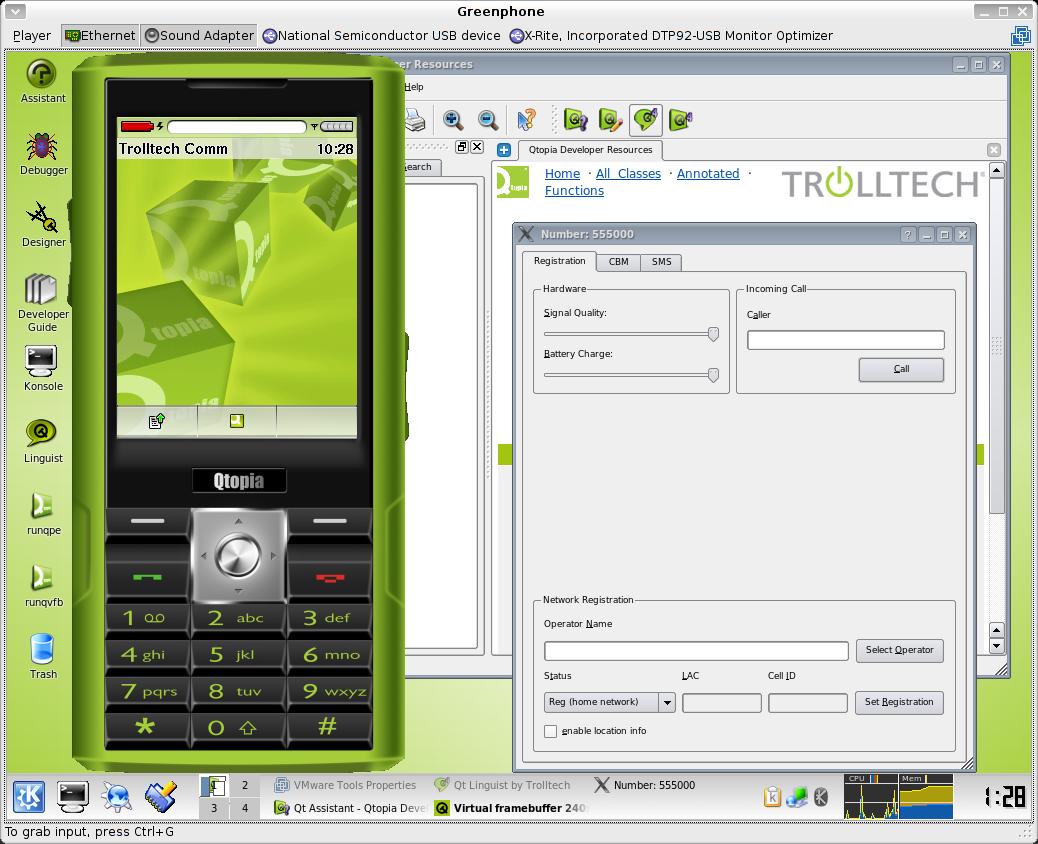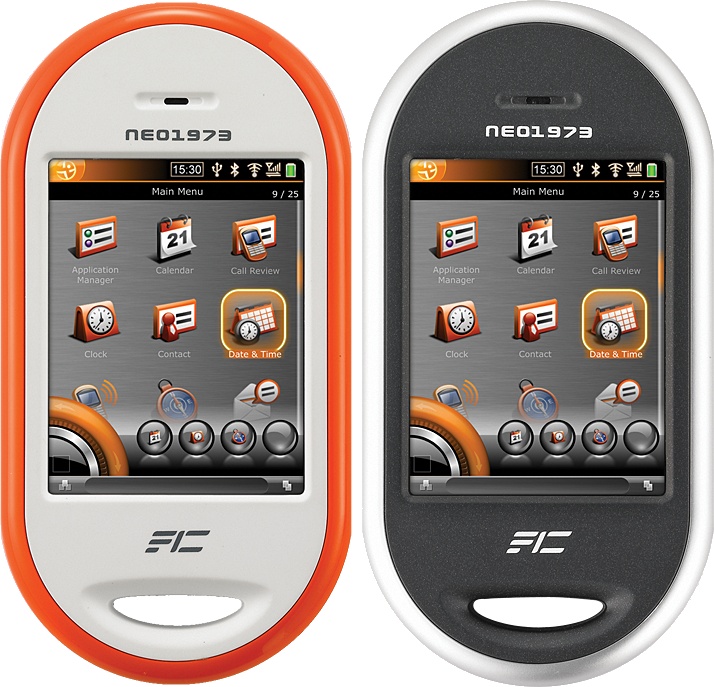So, but this is one separate distribution kit. Maybe there are (or were) some other, more successful developments? They definitely were, and they definitely are! Ok, let's
Semi-smartphones from the E28 company
Not every pioneer in their field, like Gagarin, managed to become famous and go down in history. The fate of the Chinese company E28 Limited is rather bleak, but undoubtedly deserves to be remembered - after all, the history of Linux on mobile devices began with it.
The company was founded in 2002 in Shanghai. Its founder - "the father of Linux-smartphones" Taiwanese Roger Kung - previously headed Motorola PCS Asia Pacific. He strongly advocated the use of Linux in smartphones and left Motorola in 2002 to pursue the development of his startup. The new company was named E28 in honor of the number of the school class where its founder and one of the investors from Inventec studied.
In 2003, the world's first touchscreen Linux-smartphone with a simple name E28 E2800 was released... A 2.4-inch touchscreen, a 0.1-megapixel camera, a 200 MHz processor, 32 MB of RAM, a stylus in the body, a flip with a window (just like the cases of some modern smartphones!) ... and the price is about $ 700. The device was in good demand in China and the United States, and in November 2004 the company received the Hong Kong Award for Technological Achievement .

Subsequently, the company released several more devices on the international market on its own assembly of Linux, and the glorious 2007 became the year of its heyday. Alas, she did not survive the crisis of 2008, and the official website was disabled in 2013. Apparently, its founder ( interview with him ) left the technology business.
Mobilinux
Development of the well-known company Montavista Software , designed for push-button telephones and smartphones and appeared in 2005. In 2007, the "leader in commercialization of embedded Linux," said 95% of Linux smartphones were running this system. However, it was not possible to develop local success: universal smartphoneization began, and push-button phones were left with a niche of simple and cheap devices with basic functionality, where Linux is not really needed. Even the support for multi-core processors introduced in version 5.0 (November 2007) - and there weren't any of them in smartphones for another 3 years - did not save the system. In 2008, the development of Mobilinux and its derivatives was discontinued.
As for the developer company, it successfully exists to this day, and its main development - Linux Montavista - lives and develops slowly. If you have a reader with some unspecified Linux listed in its specifications, obviously it's Montavista.
Openmoko
So we have come to the point where Linux in smartphones has become associated with geeks and tech fans! Openmoko is a project with a confusing history, a bright flash of interest and a quick demise.
So 2006. Norwegian company Trolltech has developed the Qtopia Linux platform for smartphones, handhelds and other touch devices. The system has found application in the Sharp Zaurus PDA series, Sony Mylo and Archos PMA400 / PMA430 multimedia handhelds, as well as in a number of other devices.
In 2007, Trolltech co-partner with ODM are Yuhua Teltech released Pushbutton-touchscreen smartphone Greenphone... Features - XScale 312 MHz processor, 64 MB of RAM and 128 MB of internal memory, Bluetooth, Wi-Fi. The software platform was Qtopia Phone Edition 4.1.4. The kit also included an SDK for software development. A trial batch of devices was released in December 2006, but that was the end of it. The overpriced ($ 700) negatively affected sales - that's all.

In 2008, Qtopia was renamed Qt Extended and Trolltech was integrated into Nokia as Qt Software. The Finnish giant had its own experience in the field of mobile Linux - see below - and on March 3, 2009 it was announced that it would stop developing the system. But we are in the open-source world, and all the interesting things happened in parallel!
In 2007, Qtopia was forked by Taiwanese First International Computer... The fork was named Openmoko ("Open Mobile Communications") and began to develop as a community-driven operating system. The FIC Neo 1973 smartphone was released - and its specifications were not bad at the time of release (in particular, the 400 MHz Samsung processor), but the small 2.8-inch touchscreen along with the complete absence of buttons made it difficult to use the device. The next device was the FIC Neo Freerunner - the same design, but a more powerful Samsung processor with a graphics accelerator, 256 MB of RAM and, for some reason, two accelerometers.

Smartphones running the free Openmoko operating system have generated keen interest among technology fans, but they have not achieved any widespread popularity. FIC abandoned the development of Openmoko, and the advanced community initiated a small-scale release of another smartphone - GTA04 (the same design, the same screen, but gigahertz and half a giga). The system itself, again forked as Qtmoko and also ported to OpenPandora , was somehow developed by the efforts of several enthusiasts right up to 2013, after which it finally bent down.
Bada
The appearance of this system in the history of mobile Linux is rather unusual, because Bada is not exactly Linux, but a proprietary OS that uses the Linux kernel, and nothing more. To this day, discussions on the topic "Linux is Android" do not subside. So, Bada is even smaller Linux than Android. Nevertheless, we will briefly mention her - just so as not to forget.
:format(webp)/cdn.vox-cdn.com/assets/770019/SamsungBadaWave.jpg)
So Bada. The system developed by Samsung as its own alternative to Android and designed for a wide range of smartphones: for example, the very first "badaphone" Samsung Wave GT-S5800 was considered a sub-flagship of the company (oddly enough, but in a number of sources there are references to the fact that Bada was supposedly intended for budget devices). The system turned out to be very successful and was supported by the resource of a huge company, but lost the competition to Android due to the larger amount of third-party software for it and greater openness. As a result, after 3 years it was decided to abandon it, and the most useful developments were integrated into Tizen.
Maemo, MeeGo, Meltemi
A lot has been said about Nokia's developments, everyone knows everything about them, so I will pay attention only to a few key points.

The first open-source system from Nokia was Maemo. Appeared in 2005, it was initially installed in a few PDAs, which for some reason were positioned as Internet tablets. Actually, there was only one smartphone on it - Nokia N900 (unofficial slogan: “No worries - buy N900”) and it was very popular among geeks and the IT community.
At the same time, since 2008, Intel, together with Nokia, has been cutting a Linux distribution for netbooks - MeeGo. So he would have forgotten, but in 2011 they began to port him to smartphones. At the same time, the Nokia N950 was released in limited edition (it did not go on sale, it was given to developers), and at the end of the year - the legendary Nokia N9. For its time, it was one of the best devices, and its OS drew rave reviews from journalists. Alas, the then top manager of Nokia, namely the head of the mobile division Stephen Elop, did everything possible to prevent the development of MeeGo and shake off Microsoft. Sometimes you can find mentions that the failure of the system is connected either with its shortcomings, or with the dominance of Android (although there was no such thing in 2011, and the quality of the system and its features could well have imposed competition on equal terms), or with “management mistakes ". Nothing of the kind: there were no mistakes, what happened to MeeGo is a premeditated contract murder. And the further career of Elop is the clearest proof of this.

A few words about Meltemi. This nascent MeeGo-based project was targeted at low-end smartphones. However, instead, Nokia released the Asha line of ultra-budget smartphones in 2012, equipping some of them with the old S40 platform, and some with the adapted Smarterphone OS with a graphical shell from Meltemi's developments (the so-called “Asha Platform”).
Firefox OS

Conversations (mostly half-joking) that an ordinary browser can replace all other programs for most computer users have been going on for a long time. Therefore, the very idea of making an OS from a browser for budget smartphones in 2013 looked only a little strange. Mozilla, one of the leaders in the open-source movement, has managed to attract a lot of attention to its Boot to Gecko project. There was even a partnership with Spreadtrum . But then something strange began to happen. At first, the world didn't see the promised wave of $ 25 smartphones. Then he stopped seeing anything new and interesting altogether. And in 2016, the Firefox OS project, which was heavily invested in, was declared unsuccessful and closed .
However, there is a silver lining. Part of the FF OS codebase was forked into the new KaiOS system used in the unexpectedly reborn push-button half smartphones. Now KaiOS is the third mobile OS in the world with a market share of around 5%.
Let's wish her good luck!
conclusions
The story of the arrival of Linux on smartphones is interesting and confusing. Alas, many interesting projects have not reached a state in which they could be recommended to advanced users. Some of them, developed in a semi-closed mode by hardware manufacturers, actually represented "another mobile OS" without any open source ideological load and were intended to serve the commercial interests of the manufacturer, and therefore left the horizon, being ousted by strong competitors (Android, iOS , and in one case even WP). The only project “for geeks” - Openmoko - was let down by a terrible implementation: it was not possible to install the system on a wide range of smartphones, and the “native” devices from FIH had unsatisfactory characteristics (well, just like Pinephone!).
Nevertheless, these days there are many projects of Linux-based systems for smartphones - some of them are supported by the giants of the industry and can shoot at any moment, and some are developed by "ideologically correct" methods and have all the advantages of free software associated with it. About them - in the next part. Stay tuned!